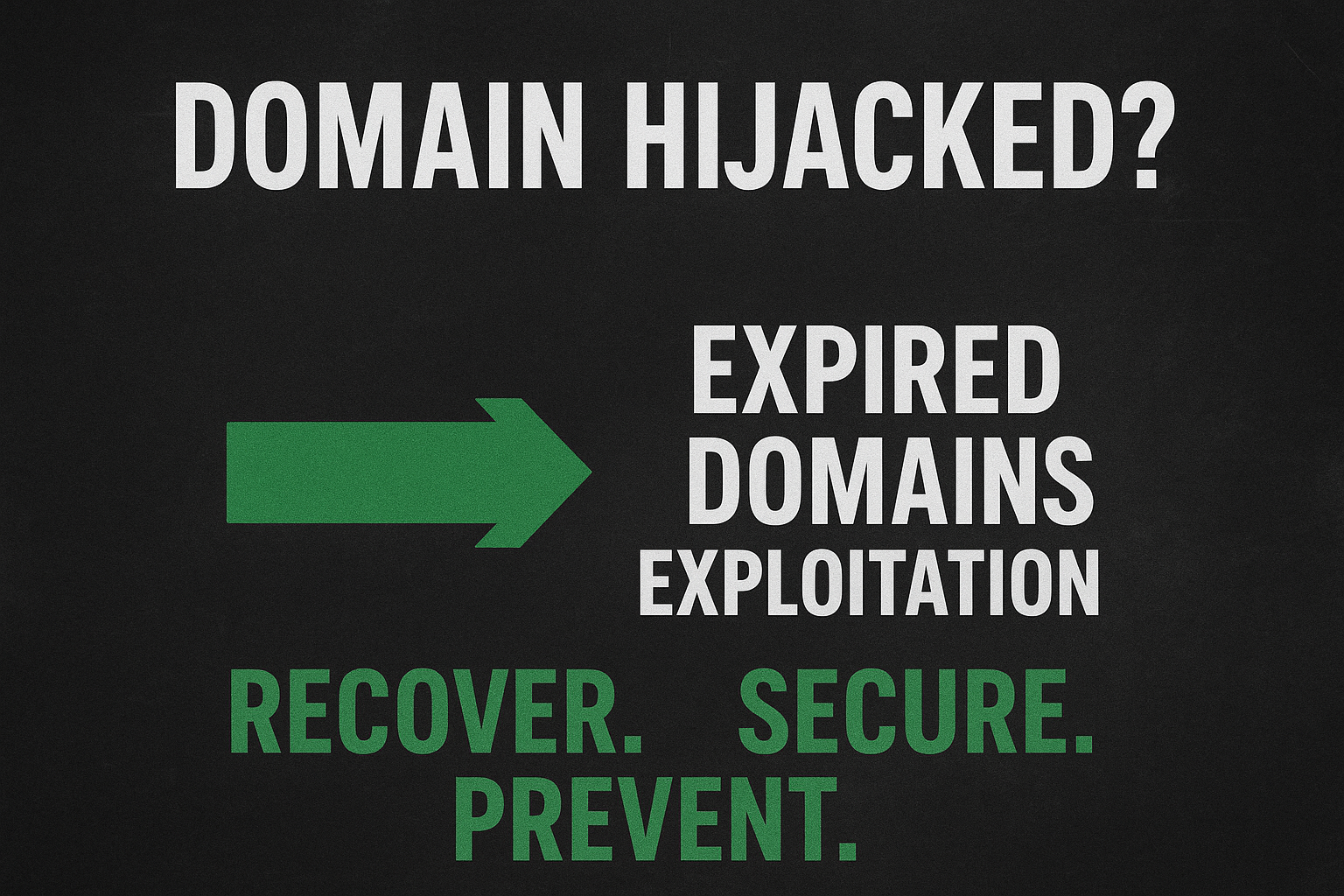The Danger of the Expired Domain Name
Most hijacked domains aren’t hacked at all.
They’re abandoned. And then weaponized.
A missed renewal or an expired credit card is all it takes.
Then someone else buys the name, and suddenly your old site hosts gambling, adult content, or malware.
What started as a simple oversight turns into a privacy and security event.
What Really Happened
Expired domains don’t sit idle.
Automated buyers monitor every lapse and grab any name with history, backlinks, or traffic.
They aren’t generally your rivals. They’re opportunists. Domain flippers, spam operators, and malware distributors who see every dropped domain as instant value.
It’s not personal. But it can poison your brand, wreck your SEO, and can corrupt your digital footprint almost overnight. Once the domain finally drops.
Why It Matters
When your old domain starts serving malicious or explicit content, it doesn’t just embarrass you. It pollutes search results, confuses partners, and can expose you to legal and reputational risk.
Search engines, advertisers, and users all trace that domain back to you.
Neglect may start the story, but exploitation writes the ending.
Know the Domain Lifecycle (for most gTLDs)
A lapse isn’t instant loss. Most .com/.net/.org names move through three post-expiry phases before the “drop.” Use this window.
| Phase | Typical Duration | Original Owner | Third-Party Status |
|---|---|---|---|
| Grace Period (GP) | up to 45 days | Renew at standard cost | Not available |
| Redemption Grace Period (RGP) | ~30 days (after GP) | Redeem with fee | Often prepped for private auction |
| Pending Delete (PD) | ~5 days (after RGP) | No recovery | Frozen until public drop |
| Dropped | immediately after PD | Lost | Bots register in seconds |
Why this matters: If you detect the lapse in GP/RGP, renew or redeem first. Don’t skip straight to negotiation or litigation unless timing forces it.
Beyond the Surface: Hidden Risks
Domain expiration isn’t just a branding problem. It’s a trust-infrastructure problem.
- Residual DNS & MX records can still resolve after expiry, creating invisible paths for impersonation and credential theft (f5.com).
- Expired domains have been used to control malware backdoors — watchTowr Labs documented over 4,000 systems reactivated through lapsed domains (The Hacker News, 2025).
- Old sub-domains and forgotten services can remain live, allowing new owners to impersonate your infrastructure or intercept communications.
When a domain expires, its perimeter stays alive.
Routine DNS/MX audits can catch these dangling records before they become takeover points.
Can You Get It Back?
Sometimes, you can get it back. Here’s how:
🔘 Buy It Back 🔘
Try to purchase it directly.
Most domain operators sell through brokers or anonymous marketplaces. Prices range from reasonable to absurd, depending on how much they think it’s worth to you.
If you try this route, always use an escrow service to keep the transaction safe.
🔘 File a Dispute (UDRP) 🔘
Under the ICANN Uniform Domain-Name Dispute-Resolution Policy (UDRP), you can challenge ownership if you can show:
- The domain is identical or confusingly similar to your name or mark
- The current registrant has no legitimate interest in it
- It was registered and used in bad faith (for example, for gambling or adult redirects)
If the domain includes your name or brand, you likely have a strong argument.
UDRP cases are typically resolved in 45–60 days, with an 85 percent success rate for clear-cut cases (WIPO 2025).
Expect administrative fees around $1,500 – $4,000, plus legal support.
Important nuance: UDRP requires proof the name was registered and used in bad faith. When a domain was abandoned and later re-registered for its traffic/backlinks (not to target you), meeting that “bad-faith registration” bar is harder. General success rates are high, but lapse scenarios often hinge on evidence of targeted intent. Plan accordingly.
🔘 Go to Court (ACPA) 🔘
The U.S. Anti-Cybersquatting Consumer Protection Act (ACPA) allows lawsuits against bad-faith registrants.
It’s slower and more expensive than UDRP. Typically tens of thousands. But can award up to $100,000 per domain in damages.
This route fits only severe, high-value cases.
ObscureIQ can advise or connect you with counsel if you decide to pursue recovery.
When to escalate to ACPA: If harm is acute (e.g., adult/malware redirects on a high-value brand), ACPA offers injunctions and statutory damages ($1,000–$100,000 per domain), plus in-rem actions when the registrant hides offshore. It’s costlier/slower than UDRP but can stop the bleeding fast and deter repeat abuse.
Note: If the domain is generic or not trademarked, legal recovery gets harder. Negotiation may be the only viable path.
Every week of inaction makes recovery harder.
Should You Investigate Who Bought It?
Once a domain falls into someone else’s hands, the question is whether to uncover who’s behind it.
The short answer: sometimes — but be strategic.
Why investigate:
Context and leverage.
Identifying the new registrant helps you understand motive — are they a flipper, a brand squatter, or part of a malware network? That shapes both negotiation and legal strategy.
Evidence for legal action.
UDRP and ACPA filings rely on proof of “bad-faith registration.” Linking the registrant to prior squatting or malicious behavior strengthens your case.
Reputational defense.
If the domain hosts harmful content, knowing the operator allows faster takedowns and coordinated reporting with hosting providers.
Why not to over-investigate:
Operational risk.
Contacting a malicious registrant directly can expose personal or organizational info. Always work through an escrow or brokerage intermediary.
Limited payoff.
Many domains are registered through privacy shields or shell entities. Tracing them takes time and budget better spent on recovery or prevention.
Legal sufficiency.
You don’t need to know the registrant’s real identity to pursue UDRP or ACPA — those frameworks are designed for anonymity and can operate “in rem” against the domain itself.
Reality check:
Covering one’s tracks is harder than it looks. Even privacy-protected domains leave metadata. Recurring payment accounts, name-server reuse, analytics tags, and hosting footprints that can expose patterns.
Professional OSINT teams (including ObscureIQ’s) can often map clusters of related domains to establish a registrant’s history or network, providing valuable intelligence before deciding whether to engage or escalate.
Bottom line:
Investigate if the cost and risk make sense, or if you suspect targeted abuse.
Otherwise, channel resources toward reclaiming or mitigating damage through structured recovery and monitoring.
Real-World Case Studies
◾ Case A: Backdoors via Expired Domains
Researchers at watchTowr Labs bought expired malware-control domains and found 4,000+ live backdoors still communicating with them.
Lesson: even dormant domains can retain live technical trust links.
◾ Case B: Legacy Infrastructure Revived for Hijacking
Spamhaus reported that the decades-old fiberlinkcc.com domain was re-registered and used to hijack IP space.
Lesson: attackers exploit abandoned infrastructure just as easily as expired brand sites.
◾ Case C: Corporate Domain Redirected to Adult Content
A Fortune 500 missed one renewal. Within 72 hours, the domain redirected to adult content and gambling sites, tanking SEO and causing brand crisis (dedirock.com).
Lesson: even major brands are one missed reminder away from reputational chaos.
◾ Case D: Academic’s Personal Domain Lost
A high-profile academic let her personal domain expire. The new owner inherited working email routes.
Lesson: domain loss can equal identity loss. Not simply visibility, but control over communication.
Prevention and Next Steps
Act fast if you’ve lost a domain.
◾ Governance & Policy
- Auto-renew on all domains; renewal alerts to shared mailboxes + SMS to Ops/Legal.
- Role-based access; PIM/just-in-time elevation for registrar accounts.
◾ Technical Hardening
- Registry Lock for crown-jewel domains; DNSSEC where feasible.
- Continuous DNS/MX/subdomain audits; kill dangling records; review SPF/DMARC/ARC.
- Monitor look-alikes/typos and recently dropped variants.
◾ Incident Triage (by lifecycle phase)
These steps align directly with the lifecycle phases above. Detect early in GP / RGP, act decisively before Pending Delete.
- GP/RGP: renew or redeem immediately; pause auctions.
- PD/Drop: attempt buy-back via escrow; parallel legal review for UDRP eligibility; if harm is acute, evaluate ACPA injunctions.
🔒 Lock What Matters (Registry Lock > Registrar Lock)
Registrar Lock prevents casual changes but can be removed if a registrar account is compromised or staff are socially engineered.
Registry Lock sits at the registry itself and requires out-of-band, multi-party verification to modify nameservers or transfer the domain. For mission-critical names (root brand, MX, SSO/IdP, core apps), mandate Registry Lock where the TLD supports it. Pair with MFA, Conditional Access, and least-privileged admin.
Only 70% of top domains use Registry Lock to protect against hackers.
Emerging Trend: The Industrialization of Neglect
AI-driven domain auctions now scoop up expiring domains within seconds of lapse, automatically prioritizing those with backlinks or authority.
AI-assisted drop-catching and registry-run expired auctions have industrialized the process. Example: Anguilla’s .ai ccTLD registry reported >$600,000 in expired-domain auction sales in a single month after moving to daily auctions and a new platform partner. Translation: anything with backlinks/authority is programmatically valued and seized within seconds of drop.
Domains tied to journalists, nonprofits, and small companies are increasingly targeted for gambling, crypto, and fraud content.
Neglect is being industrialized.
ObscureIQ Recommends
We recommend an RFP-style evaluation of monitoring options (vendor and OSINT stacks). Minimum bar: continuous lapse checks, look-alike detection, and alerting on malicious re-registrations.
- Domain Exposure Monitoring – continuous watch for lapses, look-alikes, and hijacks.
- Footprint Audits – detect live trust links to expired or abandoned assets.
- ThreatWatch Domain Alerts – active escalation when malicious re-registrations occur.
Request a Domain Exposure Briefing
ObscureIQ analysts can identify your at-risk domains and simulate a takeover attempt to show what attackers see.
Our team helps clients detect and neutralize domain-based risks before they escalate.
If you’ve already lost a domain, we can trace ownership, evaluate recovery options, and mitigate the collateral damage.
The Takeaway
Domain loss isn’t always a hack. But it’s almost always weaponized.
Renew early. Lock your registrars.
Audit your DNS.
And never assume a dropped domain simply disappears.
In the wrong hands, it becomes someone else’s infrastructure. Or your next headline.











